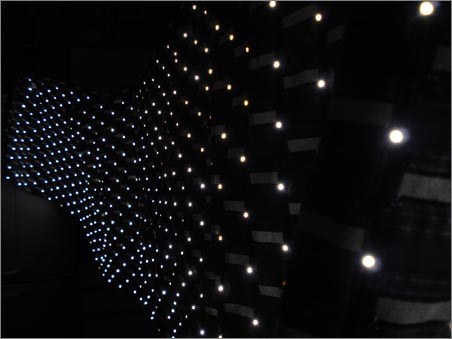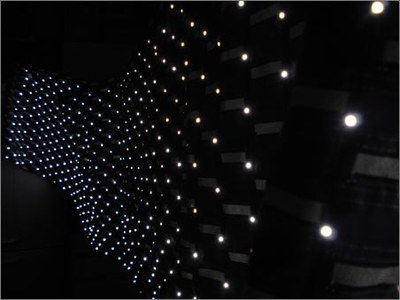E-Static Shadows: OSRAM LED in Electronic Textiles
"E-Static Shadows" is an experimental cross-disciplinary research project by designer and researcher Dr. Zane Berzina and architect Jackson Tan from insquarelab in collaboration with TITV – Textile Research Institute Greiz in Thüringen, Germany, the Computing Department at Goldsmiths and Queen Mary University of London.
The project is based at the Constance Howard Resource and Research Centre in Textiles at Goldsmiths, University of London and funded by the Arts and Humanities Research Council and Arts Council of England. The design and technology developments on the project are supported by OSRAM Opto Semiconductors and Elektrisola.
Static electricity is one of the oldest known physical phenomena. In modern domestic and industrial environments it is usually regarded as a nuisance or hazard responsible for electrostatic shocks, process problems and even industrial fires. This research aims to concentrate on its potentially positive uses and benefits for the development of new interactive environmental design strategies.
The 'E-Static Shadows' project creatively explores the speculative arena of electrostatic and its possible readings in relation to physical space and the poetic potential of static electricity surrounding our everyday interactions. By doing so it also advances the potential for technology that allows us to interact with the omnipresent but hidden electrostatic forces.
This collaborative project across the disciplines of art, design, craft, science and technology is concerned with the development of new interactive textiles systems which are capable of sensing static electricity generated by people and translating it into audio-visual patterns on the surface of the architectural fabric membranes.
The electronic textile acts as a static mirror – responding to the usually invisible charges generated by people interacting with materials and making them visible. Equipped with tiny LED lights, transistors and woven electronic circuits seamlessly integrated into the electronic textiles structure, the installation is able to create transient shadows on the textile display in areas which detect a presence of electrostatic fields, feeding on the charges created by viewers and objects. Simultaneously it acts as a simple sonic instrument in response to the presence and intensity of charges, human proximity and touch.
The underlining intention of the project is to investigate how the easily accessible but little utilised phenomena of electrostatic can add to our sensory experiences and advance the design knowledge of interactive environments. Ideally, these translations embedded in the soft medium of cloth shall provoke a higher awareness of the potential of electrostatic fields surrounding our habitat and initiate playful interactions between the viewer(s) and the space. This provides opportunities for new speculations regarding the role of static electricity within a built environment.
In order to achieve the luminous qualities of the textile display special super bright surface mount OSRAM LEDs were used. The research team was particularly interested in the fact that OSRAM LEDs allows the achievement of high brightness requiring very low electrical power thus enabling the production of large scale luminous textile systems which are safe to use. Therefore this offers more sustainable design solutions for lit environments using soft display systems.
Exhibition and Public Discussion Event:
'E-Static Shadows' will be exhibited at the Dana Centre, Science Museum London for public dissemination from the 6th of March until the 11th of March 2009 accompanied by a presentation by the research team and panel discussions with invited scientists on the 11th of March:
www.danacentre.org.uk/events/2009/03/11/459
This will be of interest to a wide range of technologists, scholars, design practitioners and educators working in the fields of intelligent textiles, responsive environments, product and environmental design, architecture and electrostatic as well as those interested in the debates around cross-disciplinary research and science and art collaborations, including the general public.
More information about the research will be available from the 10th of February by visiting the project website: www.zaneberzina.com/e-staticshadows.htm


